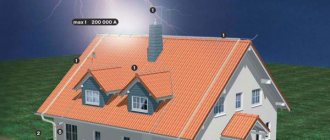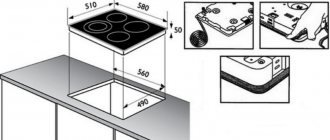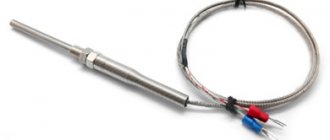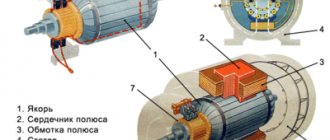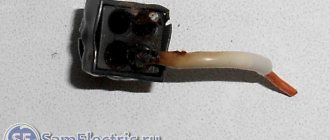Lightning protection of a house with a metal roof
Since ancient times, the flashing of lightning and the roar of thunder during a thunderstorm have caused unaccountable fear in humans. Later, people realized that it was not thunder itself that was dangerous, but lightning, which could strike buildings, tall trees, and even people and animals.
Lightning strikes often caused fires that destroyed entire settlements and left residents homeless. Therefore, it is very important to do everything possible to protect your home from lightning and its consequences.
Contents of the article
(click to open)
Internal and external system
All home buildings must be equipped with lightning protection, and for complete protection it is necessary to provide external and internal protection. The external system serves to protect against direct lightning strikes, while the internal system helps to avoid overvoltage of electrical networks in the house.
The external protective system includes elements such as:
Internal protection includes various devices, the basis of which is to turn off the electrical network of the house when a certain voltage level is exceeded. Such devices are connected directly to the break in the supply line of the house or transmit a control signal to switching devices.
Is lightning protection necessary for a metal roof?
For more than a century, metal has been most often used to cover the roofs of residential buildings. These include traditional seam roofs made of sheet steel and copper, and roofs made of metal tiles or corrugated sheets.
Although the metal roofing itself does not burn, in most cases it is installed over wood sheathing and flammable insulation coatings. They are usually the source of ignition, since when lightning strikes, melts and burns occur in the metal covering of the roof, caused by the enormous temperature of the lightning discharge. Therefore, as soon as people understood the nature of lightning, they began to install lightning rods on tall buildings in order to protect them from the strikes of the elements.
The first lightning rods were metal rods raised high on special masts, which attracted lightning discharges during a severe thunderstorm. That is why lightning protection of a metal roof with a lightning rod immediately turns your home into the target of a possible attack, endangering not only you, but also your neighbors.
When deciding on the need for lightning protection, you must first study the height of the surrounding buildings. If there are dominant objects near you, such as tall buildings, water towers or main power line supports, it is better not to rush into installing a lightning rod.
In this case, it is better to ground the metal roof. To do this, the metal sheets of the roofing are securely connected to each other and to all metal structures located on the roof and connect them to the grounding network.
Electricians call this a potential equalization system. During a thunderstorm (with close lightning strikes), huge overvoltages arise in the electrified air, which can lead to electrical discharges between various parts of the roof. Grounding the iron roof will protect the building from the occurrence of step voltages inside the house with a large potential difference.
Roof roof grounding
Roof grounding options.
A fire can be caused by more than just lightning. Static stress can accumulate in the metal of the roof, simply from the normal friction of dust particles against it. It would seem like some specks of dust, but they can ignite a serious flame. In addition, metal tile roofs are laid on roofing felt or roofing felt. And these materials are classified as dielectrics, which is why these roofs are completely isolated from the ground. Also, induced atmospheric electricity can accumulate in the metal of the roof. This usually happens during a thunderstorm. Having reached a certain amount, the electricity simply needs to be discharged.
Cable lightning rod.
The human body is perfect for this release. The discharge, in turn, can reach 10 thousand volts. This suggests that if a person suddenly touches the roof at this moment, he will receive an electric shock, which can lead to death or loss of consciousness. Also, even a small spark can cause a fire on a metal roof. To prevent all these troubles on the roof of the roof, you need to use grounding. There is such a thing as natural grounding, which is used as metal pipelines.
Here it is necessary to exclude pipelines with flammable liquids, sewerage and central heating, structures of structures and buildings made of metal or concrete. If there is no natural grounding, you should try to bury the electrode pin into the ground. The cross-section at the ground electrodes should be 50 sq. mm or more. At the same time, the thickness of the strips of profile steel or copper, as well as the walls of the pipes, should be 4 mm or more. Corrosion protection for a metal tile roof is achieved using galvanized copper or steel. It is strictly prohibited to paint the electrode coatings with bitumen. Ground resistance should be approximately 10 ohms or lower. These are the protective measures that are necessary for roofing.
If the structure or building is not so flammable, that is, they are equipped with roofs made of metal tiles and corrugated sheets, then lightning rods are used for them, which are installed specifically on the roof of the structure, after which they are connected directly to grounding.
Lightning rod installation
If your house is not protected by neighboring taller buildings, you will have to take care of its lightning protection yourself.
Most experts consider it most optimal to install a lightning rod near the house at some distance from it. Having protected the building from direct exposure to a lightning discharge, it will not cause dangerous overvoltages to occur inside the house.
If there is a tall tree near the house, a lightning rod can be installed directly on it. To do this, a metal rod is attached to a long pole so that its end is higher than the crown of the tree.
To install a lightning rod, you can also use a mast on which a television antenna is installed. If this is not possible, lightning rods are installed directly on the roof of the building. They can be placed both on the gables and on the chimney of the house.
In recent years, modern systems of so-called “active lightning protection” have appeared. In them, instead of conventional rod lightning rods, special devices are installed that send a powerful electric discharge towards the lightning, taking on the full force of its strike.
Various types of lightning protection for buildings
From the school physics course it is known that the protection zone of a lightning rod is a cone, inside of which the protected object must be located. It follows from this that the higher the lightning rod is, the larger the volume of protected space will be.
The height of the lightning rod should be approximately equal to the length of the building multiplied by three. Often, if the building is large, installing a lightning rod of the required height is very difficult and time-consuming. In such cases, other types of lightning rods are used. In addition to rod lightning rods, there are mesh and cable types.
When installing any type of lightning rod, the installation of a potential equalization system and grounding of the roof in a private house are mandatory.
External lightning protection device for a residential building
The main elements of a lightning protection system are an air terminal, a down conductor and a grounding conductor.
The most common lightning rod is a steel rod with a cross-section of at least 100 mm² and a length of up to 1.5-2.0 m. Typically, a steel rod with a diameter of 12 mm is used for this purpose.
The down conductor connects the lightning rod to the ground loop. From its very name it is clear that it is designed to divert lightning discharges into the ground. The thickness of the down conductor must be at least 6 mm, since the lightning current can reach 200 thousand amperes! The grounding of the metal roof is also connected to the down conductor.
The ground loop consists of several electrodes immersed in the ground and connected to each other. The choice of its design depends on the characteristics of the soil where the house is built.
The connection of all parts of the lightning protection system to each other must be very reliable. The figure shows various ways of connecting its various elements to each other.
The grounding loop is made at a distance of 1.5-2.0 m from the building wall on the side opposite the entrance to the house. To do this, a trench with a depth of at least 0.5 m is torn off. Grounding electrodes from steel angles or sections of metal pipes are driven into the bottom of the trench to a depth of 2-3 m.
The surface area of the ground electrodes should be as large as possible. So, the steel angle must be at least 50x50 mm in size. The larger the area of contact between the metal and the ground, the lower the spreading resistance of the grounding loop will be and the higher its efficiency.
The number of electrodes depends on the electrical resistance of the soil and humidity. In very dry weather, it is recommended to moisten the soil in the area where the ground loop is located. The electrodes are connected to each other by a steel grounding conductor with a cross-section of at least 150 mm². Most often, a steel strip with a cross section of 40x4 or a rod with a diameter of 16 mm is used for this purpose.
In wet soils with high electrical conductivity, it is permissible not to install grounding electrodes. In this case, only a horizontal ground electrode is laid in the ground. To increase the conductivity of the soil in the area of the ground loop, sometimes pits are made and saltpeter or salt is poured into them.
The figure shows the connection of the lightning protection system to the ground loop.
Connections between the elements of the grounding loop are made using electric welding, and only the welded joints are painted.
Corrugated sheeting for roofing - sheet dimensions
Width, length, thickness of corrugated roofing. What sizes of corrugated sheets for a roof are optimal? What should you pay attention to? How do the technical characteristics of corrugated roofing sheets depend on the profile shape?
Roof installation from corrugated sheets
Installation of a roof made of corrugated sheets: from lathing and roofing pie to the layout of sheets of corrugated sheets and its fastening. As well as sealing the roof, the design of the eaves strip, gables and ridge.
Roofing elements made of corrugated sheets
Why do we need additional elements for corrugated sheeting? What types of additional roofing elements are most common? How to use them? Read the answers to all these questions in the article.
Installation of lightning protection
Lightning protection of a flat roof or pitched roof structure is carried out during the installation of the roof or already during the operation of the building. It is important to correctly calculate the number of lightning rods and the contact area of the ground electrode so that the protection against electrical discharges works effectively. It is believed that the higher the lightning rod, the larger the area that it protects from lightning strikes. It is necessary that this safe area includes not only a residential building, but also the necessary outbuildings. When installing lightning protection, the following requirements must be taken into account:
- The lightning rod is installed at the highest point of the roof. Typically, installation is carried out on a ridge, on a television mast, chimney or ventilation pipe. The disadvantage of this installation method is that the high metal spire creates additional wind load and can also become deformed. An alternative installation location could be a tall tree located near the house.
- The down conductor connects the lightning rod to the grounding conductor. For its manufacture, steel wire with a thickness of at least 6 mm is used, which must withstand voltages of up to 200,000 amperes. The down conductor is laid along the shortest path, and the welding between it and the lightning rod must be very strong so that it does not collapse under voltage. From the lightning rod, the down conductor is lowered first along the roof and then along the walls of the building at the maximum distance from windows and doors. It must be securely fastened to the walls using metal clamps.
- Grounding electrodes are made of stainless steel or copper, as they have good conductivity. It is buried in the ground to a depth of at least 2-3 meters at a distance of more than 5 meters from the driveway to the house, porch, blind area. The soil at the site where the ground electrode is installed must be loamy or clayey and moist. Before a thunderstorm, you can even specially moisten the soil if it is sandy and does not hold water well.
Remember! Lightning protection requires regular maintenance to maintain its functionality. It is recommended to inspect the lightning rod annually, carefully checking the points at which it is attached to the down conductor. Once every three years, weakened contacts should be replaced or strengthened, and once every 5 years, the ground electrode should be dug out and the depth of its corrosion should be checked. If the grounding element is rusted by more than a third, it should be replaced.
Mesh lightning protection device
Advantages of mesh lightning protection
Is it necessary to ground a corrugated sheet roof?
Can lightning strike a roof covered with corrugated sheets? Nearby there is a grounded pole with electrical wires.
If there is a power line next to a private house. And this is usually exactly the case. Necessarily! You can check the aiming yourself - with an indicator. There is no need for grounding in the apartment - the wall reinforcement is grounded, so there is no interference.
This is a double-edged sword. If there are no tall trees around your home or buildings taller than your home, then there is no need to ground your roof. And if the house is separate, then grounding will greatly increase the chance of lightning hitting your roof, so I’ll say again, don’t ground it. In your case, lightning is more likely to strike a grounded pole; it is a lightning rod.
Grounding for a soft roof
Roofs made of soft roofing materials are very popular. This is due to the fact that they are quite easy to install and at the same time have high performance characteristics. In addition, they boast an aesthetic appearance. As mentioned earlier, they also need protection from lightning.
The peculiarity of installing grounding on a soft-roof roof is that only a mesh can be used as a lightning rod. In addition, grounding should be done not after the roof is completely ready, but during its installation. Otherwise, the integrity of the roof will have to be compromised.
Thus, we can draw a conclusion that grounding for roofs with soft roofs needs to be designed initially. For roofs made of other materials, this condition is not of primary importance. A lightning rod system can be installed on them later.
The need for grounding
The number of people who decide to protect their home from lightning strikes is growing rapidly. But is grounding always necessary?
Let's consider the factors that increase the risk of lightning striking a residential building:
- No taller buildings or trees nearby. In most cases, lightning strikes the tallest object. It could be a tree, a multi-story building, or a power line. Well, if this is not near the house, then the danger of being struck by lightning and, accordingly, causing a fire, increases significantly.
- The presence of a high antenna or metal roof. A metal roof, high antenna or tower for Internet reception far from a populated area significantly increases the risk, since lightning is attracted by such objects.
It would be useful to find out how often rain and thunderstorms occur in the region, and whether there have been fires due to lightning in the past. If so, then this is also an important factor to consider when deciding whether you need to ground your building.
Lightning protection of a building with a metal roof
There is a misconception that lightning protection is not required for a metal roof. They say that metal does not burn, and there is no point in wasting money.
The energy of a lightning discharge is very high, and in the absence of lightning protection on a metal roof, it can heat the metal to such an extent that the wooden structures of the sheathing and rafter system, polymer waterproofing membranes and other combustible materials underneath will ignite.
Such a hidden fire will not be immediately detected and will cause enormous damage. Therefore, lightning protection for a private house with a metal roof must be installed.
The principles of lightning protection on buildings with a metal roof are similar. This is due to the same risk factors. When air and the dust particles it contains rub against the roofing material, it becomes electrified. This can cause a discharge of static electricity without thunder or lightning.
If the area of the stingray is large, the discharge power will be sufficient to cause serious harm to the health of people or pets caught in its path. Therefore, buildings with metal roofing need a reliable grounding system for the slopes.
Metal tiles
Lightning protection for metal roofing is designed based on general principles. The lightning protection mesh should cover the entire area of the slopes in increments of no more than 6 meters. Lightning protection elements on metal tiles are attached using special brackets, fixed to the sheathing with roofing screws.
The grounding of a metal tile roof must have a sufficient contact area with the ground to discharge both lightning discharge and accumulated static electricity charges. It is better to ground a metal tile roof using a spatial welded pipe structure.
Corrugated sheet
The corrugated sheet is also made of galvanized metal sheet, covered with layers of primer, paint and polymer protective coating.
Accordingly, the principles and approaches to designing lightning protection for a roof made of corrugated sheets are no different from those for metal tiles.
Folded
Lightning protection of seam roofs is carried out according to similar principles. Compared to grounding a metal tile roof, it has higher grounding requirements.
If the roof is not painted and is made of copper or galvanized sheet, the entire slope is a large conductor and capacitor lining. Therefore, a static charge accumulates faster on it, and the potential of such a charge is higher. Accordingly, the threat of a discharge to people and structures located on the roof or in the attic is higher.
Lightning protection for soft roofs
Installation of lightning protection on a soft roof is carried out using fastenings that do not violate the integrity of the coating. If nails or screws are used for this, they must be equipped with neoprene sealing gaskets, and the installation site must be additionally sealed with bitumen mastic.
A pitched roof covered with flexible tiles is protected from lightning strikes in the same way as metal tiles. The surface of the roofing material does not conduct electric current.
The static charge on such slopes accumulates insignificantly, and it is permissible to install a less powerful grounding than for metal tiles.
Lightning protection of a flat roof covered with rolled materials consists of current collectors at the corners of the roof and a current-carrying mesh with a pitch of no more than 6 meters.
The installation of a lightning protection system is not regulated by current legislation. However, its necessity for roofs made of metal tiles, corrugated sheets, seams, and soft roofing materials is obvious to the owner who cares about the safety of his house or cottage.
Basic techniques
To protect your home from lightning, you can use two lightning rod options: a rod or an antenna. Everything is quite simple here. The rod has a single purpose - to protect your home from fire in the event of a lightning strike, discharging a huge charge into the ground. It can be made in the form of a regular rod or resemble an elegant weather vane.
The lightning rod antenna performs two functions. Firstly, as an antenna should, it catches the signal and transmits it to the TV. Secondly, thanks to the grounding cable, in the event of a lightning strike, it reliably protects your home and its inhabitants.
Today, grounding of a metal roof PUE (electrical installation rules) is divided into two types:
The first option is much simpler. If only because it is available in many homes. The most common examples are reinforced concrete foundations and metal piping. However, they are not always effective enough to cope with grounding.
Therefore, experts recommend using artificial grounding. To do this, a rod made of steel or copper is placed on the roof, from which a thick cable or wire extends, connecting it to the ground.
Design
Grounding the metal roof of a building has a simple design:
As mentioned above, a steel or copper rod can be used as a lightning rod. Copper has higher conductivity and lower resistance. Therefore, its use is preferable, but it is also more expensive. In addition, today special metal meshes are widely used, which are installed throughout the roof. Some homeowners prefer to use a cable lightning rod - a metal cable is stretched from the top ridge.
The supports should be made of heat-resistant insulator - wood is ideal.
The optimal current conductor is a steel, aluminum or copper wire with a diameter of at least 6 mm.
Finally, both rods dug into the ground and a circuit made from flat or round rolled metal, also dug to a sufficient depth, can serve as a grounding electrode.
Installation stages
The most common types of roofing in our country are soft and metal. Ceramic, due to its high cost and heavy weight, is not very popular. Therefore, let's consider these options. For ease of installation, it is better to draw up a drawing.
If your house has a metal roof, then grounding will cause a minimum of hassle - on both sides of the house you need to weld two down conductors to the roof, which are connected to the ground loop. But at the same time, it is worth making sure that between the roof and wooden rafters there is a layer of non-combustible material, for example, basalt wool. When struck by lightning, a section of the roof can become so hot that the metal melts, which can cause a fire.
It is more difficult to ensure grounding of a soft roof. Here it is necessary to use a lightning rod. Which one? Choose the appropriate one from the above.
When the installation of the lightning rod is completed, you can begin installing the ground loop.
It is best to use rolled metal for it. Round rods with a diameter of 16 mm or more, hollow pipes with a diameter of 30 mm or more and a wall thickness of more than 4 mm, a flat profile with a cross-section of 4×12 mm, or a corner with walls of more than 4 mm are suitable. Rolled metal is connected into a single circuit by welding.
You can place the outline at the corners of the building, in the form of closed triangles or squares. Or cover the entire perimeter of the building - this method is more reliable, but more difficult due to the large volume of excavation work. The depth must be at least half a meter. On swampy soil it is better to increase this figure to a meter. The optimal distance from the location of the circuit to the walls of the house is from 1 to 10 meters.
What does a lightning rod consist of: the principle and practical recommendations for its installation
The main elements of the lightning protection system include:
The lightning rod performs the function of a conductor. Mounted at the highest point of the structure. This arrangement is justified by the greater likelihood of lightning hitting it.
Note! If the building is not of simple design, in the presence of complex architectural features, it is advisable to install two or more such receiving devices.
The following structures can act as lightning rods:
- Steel rope. Two supports are mounted along the intersection of the two slopes. A cable is pulled over them. The height of the support should be approximately 2 meters. If supporting structures made of metal are used, they are isolated from the cable.
- Safety net. It is also mounted at the intersection of roof slopes. Ideal for tiled roofs.
- Metal pin. Such a rod must have a cross-sectional area of at least 100 mm², length - 0.2 - 1.5 m. Lightning protection and grounding of a corrugated roof are often implemented by choosing a lightning rod design such as a metal pin.
After choosing the design of the receiving element, it should be connected to the down conductor.
Important! Any type of lightning rod must be in contact with all parts of the top covering of the building.
The transfer of lightning charge from the receiver to the ground electrode is realized thanks to a down conductor. The role of such a highway is played by a metal wire welded to the receiving element. The thickness of the wire should be over 6 mm. The down conductor is run along the wall to the ground loop. The length of such a lightning protection element should be as short as possible.
Note! Do not break the wire. When the down conductor is bent, a spark charge will occur at the fracture sites, which can cause a fire. The down conductor should not be placed close to door and window openings when lowering it.
An important element of such a building protection system is the ground electrode. By grounding the lightning protection, a reliable connection of the earth with the down conductor is realized. The grounding design that has proven itself in practice is in the form of several connected electrodes driven into the ground.
Important! The ground electrode should be located no closer than one meter from the walls of the building. The distance from pedestrian paths, door and window openings to the ground electrode should be over five meters. Such a grounding circuit needs to be buried deep enough, the depth is at least two meters.
It is recommended to moisten the grounding device in the summer, which is associated with a decrease in the electrical conductivity of dry earth.
Connecting the roof to grounding
When the lightning rod is installed and the grounding loop is welded, you can begin connecting them or laying a down conductor.
As already mentioned, the optimal material for the current conductor will be copper, aluminum or steel wire. The main thing is that its diameter is at least 6 mm.
When connecting the grounding and the lightning arrester, you need to ensure that the down conductor follows the shortest path. Otherwise, there is a high risk of breakdown, which often leads to a fire. Also, the wire should not come into contact with any flammable or conductive materials, otherwise there is a risk of fire.
When the work is completed, you can bury the ground loop.
Is lightning protection necessary for a metal roof?
A metal roof is a large accumulation of metal that attracts atmospheric discharges, increasing the risk of fire.
Despite the abundance of summer rains and thunderstorms in our country, such fires occur relatively infrequently. Therefore, it is quite difficult to unequivocally answer the question of whether grounding is necessary for a metal tile roof.
It is impossible to say in advance whether grounding your home will be justified, whether it will save you and your property with every lightning strike, or whether it will forever remain unclaimed. But most people would agree that it's better to be on the safe side than to shiver in fear of fire during every summer thunderstorm.
Lightning protection system design
Lightning protection is a set of measures designed to prevent damage to property during a thunderstorm, as well as to avoid injuries during roof maintenance.
Lightning protection is required not only for metal roofs, but also for roofs made of other materials - roofing felt, wood, etc. When struck by lightning, a non-metal roof can easily catch fire, with likely fatal consequences.
Plus, the presence of lightning protection allows you to avoid damage to electrical equipment. Even if a lightning strike does not cause a fire, a strong discharge of current can damage electronic devices, the replacement of which is expensive. By the way, static electricity can also lead to similar consequences.
The lightning protection system consists of the following components:
- Electrode for receiving lightning. It is installed at the highest point, because the physics of lightning is such that in most cases the discharge strikes precisely at the highest point of the building. If the roof has a large area or a complex configuration, several lightning receivers are installed.
- Down conductor. Necessary for the safe transfer of energy to the ground. It is made of durable wire or reinforcement with a thickness of at least 6 mm. The down conductor is laid along a safe route that excludes contact with metal elements of the building.
- Ground electrode. Designed for safe disposal of current in the soil. It is a structure of electrodes buried in the ground connected to a down conductor. The size and location of grounding conductors is calculated according to the size of the building. In this case, it is not allowed to place the ground electrode closer than 2 meters from the building.
The number and location of pantographs is calculated based on the configuration and area of the roof. At the same time, the more sloping the roof is, the fewer lightning rods will be required. It is believed that for a small roof with a slope of 45 degrees, one pantograph is enough to guarantee that the house will be protected from fire if it is struck by even very strong lightning.
